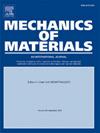利用多粒子跟踪(MPT)方法建立了表征DN水凝胶内部损伤演化的损伤模型
IF 3.4
3区 材料科学
Q2 MATERIALS SCIENCE, MULTIDISCIPLINARY
引用次数: 0
摘要
在大变形条件下,双网水凝胶表现出颈缩现象,损伤在聚合物网络内部传播。虽然对DN水凝胶的内损伤机理已经进行了广泛的研究,但对DN水凝胶的内损伤演化仍缺乏定量的描述。本文提出了一种光学全场变形测量方法——多粒子跟踪法(MPT),用于测量DN水凝胶的非均匀变形场。根据MPT方法对DN水凝胶损伤积累和传播过程的观察,提出了一种描述DN水凝胶损伤全过程的损伤模型。在该损伤模型中,损伤传播以相变为特征,损伤积累引起的应力软化用损伤本构模型来描述。所建立的损伤模型能较好地预测DN水凝胶在单调加载和循环加载试验中的整体应力-拉伸关系。此外,我们预测了第一个网络碎片的大小,并解释了DN水凝胶高韧性背后的机制。本研究表征了DN水凝胶内部损伤演化过程,证明了对DN水凝胶非均匀变形的定量描述。本文章由计算机程序翻译,如有差异,请以英文原文为准。
A damage model of characterizing the internal damage evolution for DN hydrogel using Multi-Particle Tracking (MPT) method
Under large deformation, Double-network (DN) hydrogels show necking phenomenon with the damage propagating inside the polymer network. Although the internal damage mechanism of DN hydrogel has been extensively studied, there is still a lack of the quantitative description for the internal damage evolution of DN hydrogel. In this work, an optical full-field deformation measurement, named as multi-particle tracking (MPT) method, is developed to measure the inhomogeneous deformation field of DN hydrogel. According to observation of the damage accumulation and propagation of DN hydrogel using MPT method, we propose a damage model to describe the entire damage process of DN hydrogel. In the proposed damage model, damage propagation is characterized by phase transition, and stress softening due to damage accumulation is described by a damage constitutive model. The proposed damage model can predict the overall stress-stretch relationship of DN hydrogel in the monotonic loading and cyclic loading tests. Furthermore, we predict size of the fragments of the first network, and explain the mechanism behind the high toughness of DN hydrogel. This study characterizes the internal damage evolution and proves a quantitative description for the inhomogeneous deformation of DN hydrogel.
求助全文
通过发布文献求助,成功后即可免费获取论文全文。
去求助
来源期刊

Mechanics of Materials
工程技术-材料科学:综合
CiteScore
7.60
自引率
5.10%
发文量
243
审稿时长
46 days
期刊介绍:
Mechanics of Materials is a forum for original scientific research on the flow, fracture, and general constitutive behavior of geophysical, geotechnical and technological materials, with balanced coverage of advanced technological and natural materials, with balanced coverage of theoretical, experimental, and field investigations. Of special concern are macroscopic predictions based on microscopic models, identification of microscopic structures from limited overall macroscopic data, experimental and field results that lead to fundamental understanding of the behavior of materials, and coordinated experimental and analytical investigations that culminate in theories with predictive quality.
 求助内容:
求助内容: 应助结果提醒方式:
应助结果提醒方式:


